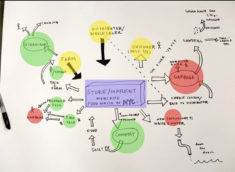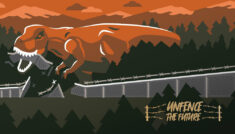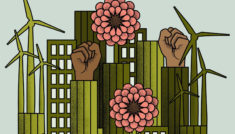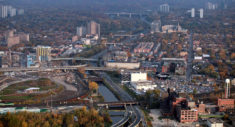About the Research Fellowship
The Center for the Humanities at the Graduate Center, CUNY and The Natural History Museum collaborated to help fund and facilitate Robin Renée Robinson as Graduate Research Fellow to engage in research on the topics of natural history, environmental justice struggles, and museums. The Research Fellowship is part of Art, Activism, and the Environment, an interdisciplinary research group led by Professor Ashley Dawson as part of the Mellon Seminar on Public Engagement and Collaborative Research. The Seminar employs public practice to amplify the intellectual and creative work at the intersection of the public humanities, the digital humanities, the humanities-related social sciences, and social justice. Robin Renée Robinson as the Research Fellow produced critical early-stage research for The Natural History Museum’s programs developing over the next five years. The Natural History Museum is a mobile and pop-up museum that highlights the socio-political forces that shape nature. Its programs take place within established museums and in the field.
Robin Renée Robinson is currently working on her dissertation, tentatively titled “Moving to Opportunity While Staying Put: Recognition as the Means for Native Americans.” Her research explores the dynamic conflicts that arise when federal, state, and municipal laws supersede the laws recognized on Native lands that have been passed down from generation to generation through oral histories. This investigation becomes even more complex when environmental justice issues arise. Her work with the NHM has given her the opportunity to explore the nature of environmental conflicts as they pertain to U.S. government vs. Native American land use decision making.
Read more about Robin's research working the Ramapough Lunaape Nation:
Who’s Land is it Anyway?: Can Recognition Mend Fractured Political Power Dynamics for Native Americans?
By Robin Renée Robinson
Many of the First Nations in the United States are located in areas that cover more than one state, county, and/or municipality. These territorial boundaries are determined by the federal government and do not show consideration for the boundary lines of First Nations – Tribal organizations, Reservations, Tribal Groups - as encompassing one single unit. This study will demonstrate the fractured state of Native American Tribes and the negative implications of boundary lines imposed on these groups that fracture the extent of their political power and environmental activism as they attempt to defend their rights and their land. This research uses the Ramapough Lunaape Nation as an example.
In the fall of 2016, The Ramapough Lunaape Nation – located in Northern New Jersey and Downstate New York – joined in solidarity with the Standing Rock Indian Reservation in their fight to fend off the construction of the Dakota Access Pipeline slated to funnel through their lands. As part of their demonstration of unity, the Ramapough gathered in protest and prayer on their land at the Sweet Water Prayer Camp located in Mahwah, New Jersey. Situated alongside an affluent, private community, the Ramapough are under the watchful eye of their neighbors when gathering at the Camp. To accommodate the protest, the Tribe erected teepees at the site, and soon after complaints were made to township officials. In December of 2016, the Tribe was issued summonses from Mahwah Township, when they refused to remove the teepees from their land. Citing zoning laws, the Township proceeded to sue the Ramapough for erecting the teepees without obtaining the proper permits. Subsequently, permits were sought by the Tribe and denied. In turn, the Ramapough went to court to defend their right to use their land for religious ceremonies.
The Ramapough have a long history of environmental degradation of their land, discrimination, and negative stereotyping by the surrounding community. Though New Jersey recognizes the Ramapough Mountain Indians as a Tribe, neither the federal government nor the state of New York has recognized the Tribe. This research analyzes the transcript of the October 2017 teepee trial – Mahwah Township vs. The Ramapough Mountain Indians – along with interview data to uncover issues of conflicting civil rights perceptions from both sides and how municipal, county, and state laws can negatively impact multi-community Tribes. The study also employs ArcGIS to demonstrate the complexity of the various state and local government entities involved in determining the rights and responsibilities of the Ramapough Lunaape Nation and how this fractures their power.
About The Natural History Museum
The Natural History Museum is a mobile and pop-up museum that highlights the socio-political forces that shape nature, yet are excluded from traditional natural history museums. The role of The Natural History Museum is to orchestrate various persuasion, support, and provocation strategies to help move science and natural history museums toward a more engaged practice with the communities they serve, and with those who are invested in a practice of science that is inclusive and reflective of our current and future planetary realities. The museum is a project of Not An Alternative, a non-profit collective that works at the intersection of art, activism, science, and critical theory. Named in The New York Times and ArtNet’s “Best in Art 2015” round-ups, the group’s work has been widely exhibited in museums and profiled in news outlets around the world.
About Art, Activism, and the Environment research team:
This Art, Activism, and the Environment research team focuses on this unfolding conjunction of art, ecology, and activism in the context of today’s climate emergency, situating such work in a history of engaged and environmentally minded art production.
About the Center for the Humanities
The Center for the Humanities at the Graduate Center, CUNY encourages collaborative and creative work in the humanities at CUNY and across the city through seminars, publications, and public events. Free and open to the public, our programs aim to inspire sustained, engaged conversation and to forge an open and diverse intellectual community.

Cosponsored by The Natural History Museum and Art, Activism, and the Environment, an interdisciplinary research group as part of the Mellon Seminar on Public Engagement and Collaborative Research.




